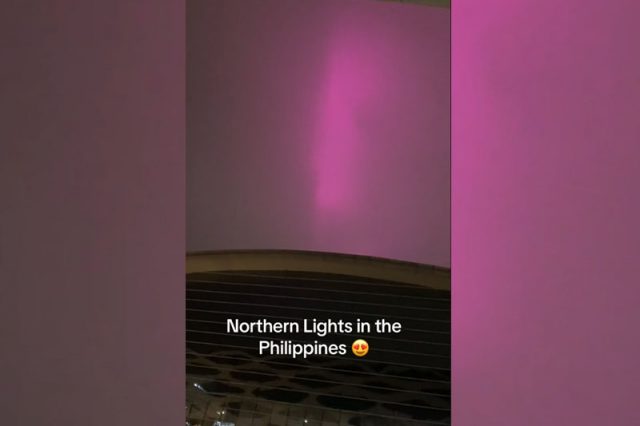Did the Philippines experience the elusive Northern Lights or Aurora Borealis in the area of the SM Mall of Asia Arena in Pasay City?
A TikTok user claimed to have seen the lights that have recently been populating the timelines of most countries in the Northern Hemisphere.
“Northern Lights in the Philippines,” she wrote with a heart-eyed emoji.
Her video showed a pink-purlish haze appearing behind the SM Mall of Asia Arena.
@sirenasiana Aurora Borealis or Northern Lights in the Philippines 😍🤩 #auroraborealis #northernlight #philippines #mallofasia #foryou #tiktokph ♬ Late Night Vibe – Rude Boy
This caught the attention of Ernest Macalalad, a user on the X (formerly Twitter) with a Ph.D. in Space Science.
“Hindi po aurora borealis ‘yung nakita sa may MOA… (sa TikTok). Diffused light lang po ‘yun sa mga ulap gawa ng mga ilaw sa paligid,” he wrote on May 15.
“Hindi po kayang makunan ng ganyang kalinaw ang isang totoong aurora kung wala ka sa poles. Nakikita po ang aurora kung clear ang sky,” Macalalad added.
Hindi po aurora borealis yung nakita sa may MOA… (sa tiktok).
Diffused light lang po yun sa mga ulap gawa ng mga ilaw sa paligid.
Hindi po kayang makunan ng ganyang kalinaw ang isang totoong aurora kung wala ka sa poles. Nakikita po ang aurora kung clear ang sky. pic.twitter.com/C7X4U5gU5d
— Ernest Macalalad🇵🇭 (@iamernestpm) May 15, 2024
Another TikTok user, @bluemug2, claimed that what the other TikTok user saw were lights from the building of MOA.
“I was there and inisip ko nun some sort of phenomena until I saw MOA’s facade,” user @bluemug2 commented.
Several countries worldwide have witnessed the display of the Northern Lights lately due to a series of powerful solar storms across the Northern Hemisphere.
READ: Auroras dazzle in Latin America as solar storm causes rare displays
The dancing ribbons of light are created when energized particles from the sun slam into the earth’s upper atmosphere at high speeds.
Due to the earth’s magnetic fields, these are redirected towards the poles — the Northern and Southern Pole, which are the northernmost and southernmost points of the earth, respectively.
The process transforms into a cinematic atmospheric phenomenon that amazes people.
The bright lights are dictated by the chemical composition of the earth’s atmosphere.
“Some of the dominant colors seen in aurorae are red, a hue produced by the nitrogen molecules, and green, which is produced by oxygen molecules,” Billy Teets, director of Dyer Observatory at Vanderbilt University in Nashville, Tennessee, said to Space.com.
The aurora can be spotted in an area within an approximately 2,500-kilometer radius of the North Pole.
Meanwhile, the Philippines is located near the equator, which divides the earth into the Northern and Southern Hemisphere.
The country’s location makes it unlikely to experience the northern lights.










